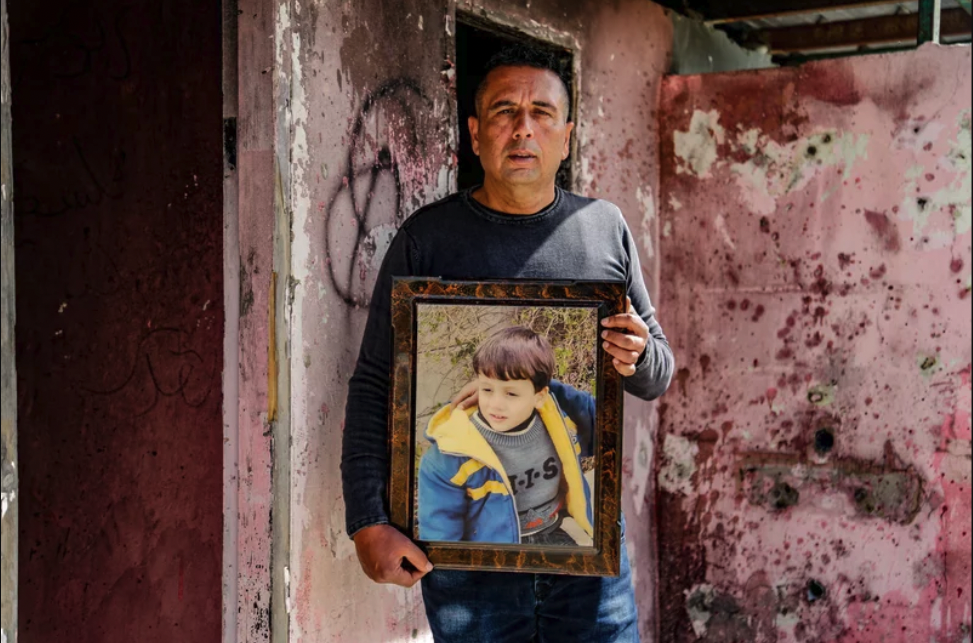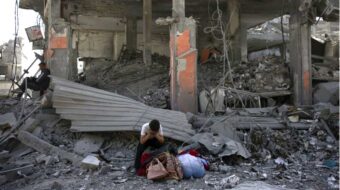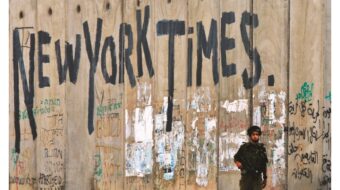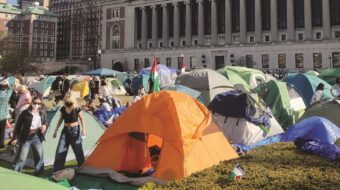
Nathan Thrall is a Jewish American journalist and former director of the Arab-Israeli Project, who now lives in Jerusalem. He has said that, as a critic of Israel, he is a lonely voice in his adopted home country. A Day in the Life of Abed Salama is a deeply researched exposé of two related mass tragedies, one of them the sudden product of a single moment, the other ongoing and seemingly perpetual.
The title refers to February 16, 2012. At 8:45 on a rainy Thursday morning, Abed Salama’s five-year-old son Milad, one of 60 children on a school outing, was involved in a hellish bus accident with multiple victims on the Jaba Road north of Jerusalem. Thrall’s account of the incident and the hours that followed, during which the father searched frantically for his son, lays bare the daily humiliations of one man’s life while starkly documenting the collective suffering of Palestinians under Israeli rule.
The book’s faithfulness to the factual record can be confirmed by comparing it with the initial report of the Jaba crash in the Jerusalem Post. It’s easy to see how the breaking news story sparked Thrall’s need to know more. From the beginning, the horror served as a metaphor and microcosm.
Under the headline, “Eight killed, 36 injured in school bus accident,” the Post stated. “An Israeli-Arab driver smashed his truck into a Palestinian school bus north of the capital on Thursday morning, killing at least seven children and a teacher.” The bus had overturned and caught fire. “Anyone who is alive from that accident—it’s a miracle,” said Dubi Weisenshtern, an Israeli rescue and recovery volunteer. The cause of the accident, the Post noted, “was believed to be wet road conditions.”

Palestinians saw other causes. Fathi Abu Mughli, Health Minister for the Palestinian Authority, blamed Israeli authorities for some of the deaths: “The IDF (Israeli Defense Forces) didn’t intervene the minute the accident took place. If it did, it could have saved some lives.” Abu Mughli added that the accident took place in an area under Israeli control, where Palestinians were restricted. He seized the moment to call on the world to “end the occupation so we can serve our people better.”
Ibrahim al-Rifai, Mayor of the West Bank town where Abed and his family lived and where Milad attended school, told the Post that the road where the accident happened was very dangerous, a three-lane highway with no barrier separating oncoming traffic. “There is a safer road that goes into Ramallah through the Beit El settlement,” al-Rifai said. “However, Palestinians are not allowed to use it.”
Israeli military sources dismissed the mayor’s insinuations, and Deputy Health Minister Ya’acov Litzman declared Abu Mughli’s statement “a lie and incitement and totally out of place.” Litzman claimed that rescue teams came immediately to the accident and that “some of the injured were being treated in our best Israeli hospitals,” adding, “In matters of human life, there are no borders and no politics.”
Borders and politics were actually the essence of the tragedy. The purpose of Thrall’s book is to give a human face to lives hammered down by systemic oppression. The author’s narration is the product of his interviews with witnesses, each of their accounts woven into a tapestry of perspectives that vividly recreates the February 16 disaster and its long historical foreground.
Nader Morrar, a Palestinian, was the first paramedic on the scene, arriving at 9:04. He knew the site and had heard it called “the death road.” He assumed the Israeli ambulances would already be there because the road was under Israeli control. To his surprise, there were no Israeli emergency services and no police. He saw the school bus, overturned and burning, and bodies on the ground. Morrar believed that, in a crisis, the different legal statuses of victims should be irrelevant. But he knew that he could never, under any circumstances, bring someone Jewish to a Palestinian hospital, though he had brought Palestinians with citizenship to West Bank hospitals. He would now ferry two more. He treated a child and one of the teachers, giving them oxygen and stemming the loss of blood while trying to stay focused through their cries.
Eldad Bernshtein, an ambulance driver and paramedic, was the first Israeli on the scene. Though Israeli ambulance services were a minute and a half away, he arrived 24 minutes after the crash. Just as he arrived, ambulances drove in from the Rama military base less than a mile away. Bernshtein was certain that any passengers left on the bus would be dead by the time firefighters arrived. Realizing he wasn’t needed, he quickly left the area. But the accident scene —the burning smell and charred bodies—had taken him back to his first days as a volunteer in the 1990s and the string of suicide bus bombings during the First Intifada.
A Palestinian rescuer named Salem had carried the last child off the bus before nearly passing out from exhaustion. When the firefighters arrived, he vented his anger: “You’re an hour late!” he screamed. “You killed them!” he shouted over and over to every paramedic and firefighter, whether Palestinian or Israeli. He saw significance in one fact: The Palestinians weren’t even allowed to be on the Jaba Road without Israeli permission, but still they’d arrived first. The Israelis had no excuse. “If it had been two Palestinian children throwing stones on the road, the army would have been there in no time,” he said to himself.
On the morning of the accident, Huda Dahbour, a 51-year-old endocrinologist and single mother, left her Ramallah apartment and struggled through the wind and rain to meet her staff. As the manager of a mobile health clinic run by the UN organization for Palestinian refugees, they were scheduled to make a regular visit to the Bedouin encampment near Khan al-Ahmar. These were members of the impoverished Jahalin tribe that had been forcibly displaced in 1948 and confined to a reservation while their land was confiscated. Huda was known for flouting the rules when her conscience dictated. After the UN organization made budget cuts that limited prenatal care to patients deemed “at risk,” she gave that designation to every pregnant woman she encountered and, when confronted by her supervisor, proudly admitted her transgression.
In the minibus on the way to Khan al-Ahmar with her staff, Huda came face-to-face with a gruesome sight: a school bus flipped on its side, engulfed in flames. She and her team jumped out and rushed to the bus. As they began to pull the driver out, whose body was stuck and his legs aflame, he yelled to them to save the children and their teacher.
The stench of burned hair and flesh made Huda recall the worst day of her life. On October 1, 1985, as a 25-year-old doctor fresh out of medical school and working with the Palestinian Red Crescent, she had treated the families of PLO fighters when Israeli F-15s had dropped 2,000-pound bombs on Hammam Chott, a suburb of Tunis, killing more than 60 Palestinians and Tunisians. The bus accident and the bombing raid, both pervaded by the putrid smell of death, seemed to her the same hellscape.
Abed Salama was asleep when his son left for school on the day of the class trip for the kindergartners at the Nour al-Houda Private Academy. It was his day off from his job at the Israeli phone company. His wife, Haifa, helped the boy into his uniform.
When Abed got up, it was gray outside and raining heavily. He and his cousin Hilmi drove together on a meat-buying errand to a friend’s store in Dahiyat a-Salaam. Stuck in horrible traffic, Abed received a phone call from a nephew: “Did Milad go on the outing today? There was an accident with a school bus near Jaba.”
When Abed reached the hospital in Ramallah, he forced his way through a chaos of shouting parents and was told that his son was on a second bus and was safe; then he was told that Milad was seriously injured and transferred to another hospital where Abed couldn’t go with his green ID card. After that, he was told that Milad had been taken to an Israeli military base, then that he hadn’t even gone on the trip. Other parents and Milad’s teachers all contradicted each other. Abed felt he was being dunked in barrels of water, first boiling, then freezing. All the while his phone kept ringing with calls from journalists and radio stations—he gave the phone to his brother Bashir and told him that would talk only to Haifa.
At eleven that night, there was nothing left to do but wait for the results of the DNA test that would tell Abed whether one of the five charred corpses in the hospital morgue was his son. Arriving home at midnight, he found his four daughters crying, clutching Milad’s clothes, and breathing in their brother’s scent. Abed knew that some of the parents had only just located their children, 15 hours after the accident. But he also knew that the possibility of his son ever coming home was less likely with each passing minute. He went to the bedroom, where Haifa was sitting on the bed. Normally Milad would be sleeping there between his parents. At the sight of the empty space, Abed broke down, heaving and sobbing in Haifa’s arms.
Thrall’s telling of Abed’s story enumerates and catalogs the poisonous indignities of life under apartheid:
- Segregation begins at birth. Many Palestinians are born in hospitals that separate Arab and Jewish maternity patients.
- In the event of a mass casualty event like the Jaba bus crash, men will greatly outnumber women in the hospital emergency rooms because men are more likely to have work permits that allow them to enter Jerusalem. Palestinian mothers without permits are prevented from searching for and attending to their injured children.
- Palestinian families living near Jerusalem pay about $1000 per year to send their children to private schools because they don’t want their children to go through checkpoints every morning to attend the city’s public schools. Schools like the one Milad attended are the only way to avoid the daily psychic wound of passing through checkpoints in order to learn.
- Compensation for families of crash victims comes with ethno-religious restrictions. Israeli law specifies that anyone hit by an Israeli-owned vehicle is due compensation (about $200,000 in the case of the Jaba crash) but only if the victims are Israelis, or Israeli-Arab holders of Blue ID cards, or tourists. Green ID holders such as Abed are not only denied freedom of movement; they are barred from Karnit, the government fund for accident victims, and receive no money.
A Day in the Life of Abed Salama also exposes a general failure to address factors that led to the Jaba tragedy in its aftermath. Thrall’s Epilogue serves as a summation:
- No one has called attention to the chronic lack of classrooms in East Jerusalem, a shortage that led parents to poorly regulated West Bank schools, which in turn led to hiring an illegally registered 27-year-old bus to drive children to a play area on neglected, congested roads without proper lighting or a barrier between lanes of oncoming traffic.
- No one pointed to the separation wall and the permit system that forced a kindergarten class to take a dangerous detour rather than driving to playgrounds a stone’s throw away.
- No one realized that the absence of emergency services on one side of the Israeli-Palestinian separation wall was bound to lead to deaths.
- No one acknowledged that Palestinians in the area were neglected because the Israeli state aimed to reduce their presence in greater Jerusalem, the place most coveted by Israel.
For these conditions, which are the true cause of the atrocity, no one was held to account. Who was held accountable? The driver of the truck that hit the school bus. He received 30 months in prison for gross negligence.
Upton Sinclair once remarked that “history is the great novelist,” meaning that muckraking literature derived its power from raw facts, amplified by outrage. Though Nathan Thrall might agree, his method eschews amplification in favor of understatement. Nevertheless, his journalistic approach—all hard evidence, minus the rhetoric—makes for a mighty book.
A Day in the Life of Abed Salama: Anatomy of a Jerusalem Tragedy
By Nathan Thrall
New York: Metropolitan Books, 2023, 256 pages
$25.44 Hardcover
ISBN-13 978-1250854971
Also available in an audio edition
We hope you appreciated this article. At People’s World, we believe news and information should be free and accessible to all, but we need your help. Our journalism is free of corporate influence and paywalls because we are totally reader-supported. Only you, our readers and supporters, make this possible. If you enjoy reading People’s World and the stories we bring you, please support our work by donating or becoming a monthly sustainer today. Thank you!












Comments